make primitive structures
All operational methods of CJocrPrim class can be done after making primitive structure. "Primitives" are defined as a connected component of bit 0 region or bit 1 region. The connectivity is defined as 4 direction or 8 direction. ALPRIM supports both connectivity.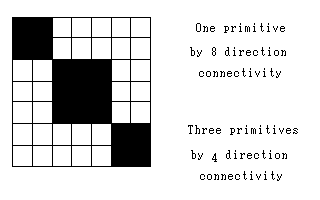
In this table, same image is defined as one primitive and three primitives. Only horizontal and vertical connections are considerd in 4 directions connectivity. Oblique connections are considerd in 8 directions connectivity.
Normal Japanese document consists of from tens of thousands to hundreds of thousands of primitives. After making strusture of primitives, user can select and operate on primitives.
abstract cluster(textblock or paragraph)
We call a set of primitived as "cluster". They are collected by some criterion. For document processing, we can grasp cluster as text paragraph or text line. The criterions of cluster abstraction are, size and area of primitives, distance of primitives and number of primitives inside cluster, size of cluster and so on.Table abstraction
We define "table" as a set of cluster, which is separated/surrounded by grid lines.Grid lines does't need to be straight, so we can manage hand written tables.
Example of table
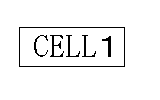 only one cell
only one cell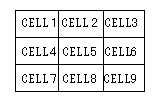 nomal table
nomal table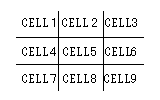 without outmost frame
without outmost frame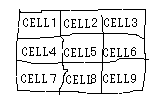 handwritten table
handwritten table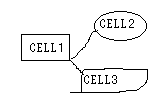 this also is a table
this also is a tableselect primitive
You need to move primitives to another layer before doing operation on primitives.
You can show the result of layer classification by showing layer bitmap. You can get both monochrome bitmap and 255 index color bitmap.
The following list shows how to select primitive.
- Select primitives inside right-angled rectangle. Primitives that touch frame are not selected.

- Select primitives inside right-angled rectangle and on frame.

- Select primitives inside any-angle rectangle. Primitives that touch frame are not selected.

- Select primitives inside any-angle rectangle and on frame.

- Select primitives that touch line.

select primitives by line
Select primitives that touch line with neighbour primitives. This function act as selection of one line text.
layer operation
You can do operations on primitives belong to same layer. You can move primitives repeatedly from one layer to another.If you move text paragraphs from layer 0 to layer 1. Primitives that don't belong to text paragraph exist in layer 0 and primitives that belong to text paragraph exist in layer 1. After this operation, if you move small primitives from layer 0 to layer 2, you can get dot noise in layer 2. If you move small primitives before separate text paragraph, small primitives that belong to character image would be selected as noises.
CJocrPrim class supports 255 layers. The initial primitives are all belong to layer 0.
CJocrPrim support layer operations as follows.
- Delete layer primitives
- Convert layer primitives to bitmap
CJocrPrim also support raster editing operations to a primitive and cluster. This operation is rarely used in OCR operation, so we don't describe the detail of raster editing operations. See reference manual for raster editing operations.
- transform primtive
- cut primitive
- delete primitive
- move primitive
- insert primitive
calculate features of primitive
ALPRIM calculate features like area, outline length , moment , line width and circleness of primitives. You can use these features as criterion to classify primtives.(classification of primitves is equal to moveing primitives to another layer)convert to bitmap
ALPRIM can convert layer primitives to bitmap. It also can convert a primitive or cluster to bitmap. Cluster is identical with text paragraph in document recognition, getting cluster bitmap means getting paragraph bitmap.- monochrome conversion
- Convert specified layer to monochrome bitmap
- Convert specified rectangle and specified layer to monochme bitmap at specified
magnification
- Convert specified layer to monochrome bitmap
- 255 indexed color conversion
- Convert specifled rectangle to 255 indexed color bitmap at specified magnification
- Convert specifled rectangle to 255 indexed color bitmap at specified magnification
Subclasses of CJocrPrim class
CJocrPrimEX class is a subclass of CJocrPrim.CJocrPrimRD class is a subclass of CJocrPrimEX.
The functions and performance of cluster abstraction is enforced largely in CJocrPrimEX class
We also enforce the performance and accuracy of angle inferrence in CJocrPrimEX class.
CJocrPrimEX also has function to infer text abstraction parameters from document image automatically and to recognize dot line in document images.
CJocrPrimRD class has more powerful functions to infer angle of cluster.
We also provide other functions for raster vector conversion and raster editing functions in CJocrPrimRD class. But we don't explain those functions as a part of ALPRIM library, because they have nothing to do with OCR process.
We strongly recommend you to use CJocrPrimRD class for CJocrPrim class, because performances of some methods are far better than CJocrPrim class. Of course, CJocrPrimRD class include all methods in CJocrPrim class.